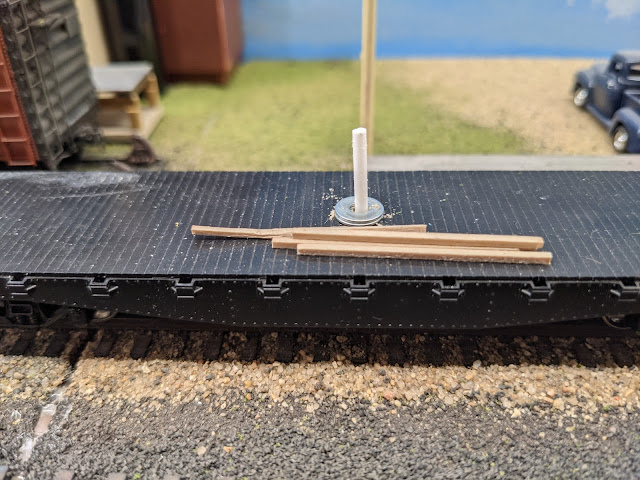This is a scratch built Cockshutt 18' discer seeder a replica of the one we used when I farmed. Discers were made by many companies. Bill is using this to do summer fallow. A discer with a seed box is something that is not likely to ever be mass produced as a model. I have never even seen one in 1/64 by Ertl. They were used for seeding on the prairies until the 70's when drills made a comeback. You will see older models of these with or without a seed box and you may see them referred to as "one-way". This is because you can only go one way around the field with them in a counter clockwise direction. The discer does not turn very sharp to the right at all and you can not back up with it. This discer would require about 80HP to pull. They could be hooked together to make them as long as you would need. The actual width of cut is always less than the length because of the angle they pull at.
One of the hardest things in this build was finding the disc blades. They had a 6" spacing so I would need 16 of them. The next hardest thing to find was proper tires (which are now available at Shapeways). I drew it out in CAD from memory referencing a couple of pictures that I have. The two 9' grain/fertilizer boxes were built from .01 styrene sheet and the ends were built from .02 styrene. I also cut 2 extra ends and sanded them down so they would fit inside and then wrapped the .01 around these and glued them together. The lid on the top was then made. This lid would have opened tilting up from the back. With the box done I then laid out the frame and made supports for the boxes to sit on. The disc gangs were next and after a few attempts I decided to make them from .01 styrene using a leather hole punch which left the 16" discs slightly dished out looking quite realistic . The discs were then drilled in the center and were mounted to an .02 wire. Supports were also added between the blades to mount it to the frame. There were 6 gangs each being 3' long. After the gangs were on I added the walkway on the back. As I explained in my garbage can post there were a couple of boxes and a couple of gangs that ended up in the bin! The T bar on the front wheel sets the height of that end of the discer and depends on the depth of the furrow. The angle of the discer cut can be changed by adjusting the hitch. I also added a hydraulic cylinder and the hose that goes back to the tractor. The drive that turns the seed wheels inside the cups sits under the box and is driven from the land wheel, which is the wheel on the front right side. I did not model the feed tubes that run from the bottom of the box back to each disc blade. I had some Cockshutt logo decals made for the ends of the boxes The total weight of this model is only 0.1oz. It was a very challenging build but I like how it turned out.








